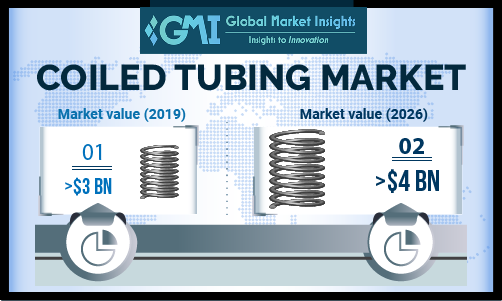The oil and gas industry enjoys a strong position in the world currently with nearly 95.55 million barrels of oil being produced daily in 2021. Predictions have been made that the total global production is set to reach 102.97 million bpd by 2023.
The increasing exploration and production numbers are supporting a steady development of the O&G segment across the world, paving way for the growth of different drilling and intervention tools that are poised to be the future of the multi-billion-dollar industry through 2026.
One such potential tool that has now been gaining massive traction amongst different E&P activities is the coiled tubing. Since its introduction in the mid-1960s, the product has now been significantly developed to be used as a drilling and intervention tool for diverse applications in oil and gas drilling and exploration processes.
Why did coiled tubing gain traction in oil and gas sector?
The answer to this lies in the very fact that coiled tubing is used as an economical solution for numerous well work and intervention applications. It offers a critical advantage – the ability to constantly circulate through tubing while leveraging the coiled tubing pressure control equipment. The tool is also long recognized to aid operators tackle different challenges that affect oil and gas wells and deplete production over time, for example, volatility in the well production and injection pressure.
Drilling with coiled tubing has been quite a feasible option for operators and contractors for many years now. In May 2021, Halliburton- a world leader in hydraulic fracturing operations- declared using the largest-ever coiled tubing intervention system for furnishing Deepwater Gulf of Mexico operations. In another instance, during the previous year Logan Industries announced delivering a custom-built skinny coiled tubing lift frame for a client in Trinidad.
As the opportunities continue to surge worldwide, the coiled tubing market value is slated to grow beyond $4 billion by 2026 end, making it one of the fastest evolving segments in the oil and gas industry.
While well services and workover applications account for nearly 75% of the coiled tubing use, ongoing technical developments have augmented the utilization of the tool in both drilling and completion applications. For example, the introduction of fiber-optic-equipped coiled tubing for real-time monitoring.
Will fiber optics-equipped coiled tubing be the upcoming trend in the industry?
A recent study revealed that by making use of coiled tubing equipped with fiber optics and downhole measure tools, O&G industry operators and engineers were able to perform a data-driven operation based on real-time measurements. In fact, this development is anticipated to help overcome stimulation problems, offering a 75% improvement in productivity compared to the other treatments.
Having said that, novel technological advancements in the space would positively open new frontiers for the global coiled tubing market in the near future.
Middle East and Africa- a hotspot for coiled tubing industry
Undoubtedly, the Middle East is one of the highest revenue-generating continents when it comes to the oil and gas industry. As per reliable estimates, the region is responsible for the largest share of world oil production, with countries like Saudi Arabia, the UAE, Israel, and others churning optimum profits.
Consider the following facts and figures:
- Saudi Arabia currently holds 17% of the world’s oil reserves. It is also one of the largest exporters of crude oil in the world and holds a production capacity of approximately 12 million barrels per day.
- 30% of the United Arab Emirates’ GDP is directly based on oil and gas output.
These statistics point to the fact that the thriving oil and gas businesses across these countries would provide optimum room for the development of drilling operations. The growth in MEA coiled tubing industry can be credited to the increasing investments in the region’s upstream oil and gas sector.
For instance, in December 2021, the Abu Dhabi National Oil Company (ADNOC) announced approving an investment plan of $127 billion over the span of 2022 to 2026, as the UAE seeks to bolster its position as a global competitor in the O&G reserves. This investment plan has been carried out by ADNOC in partnership with Mubadala and TAQA.
Propelled by such a healthy injection of investments, coiled tubing market in the Middle East is estimated to foresee an upward trend over the stipulated time frame.
The coiled tubing industry is acclimatizing to the change in business environment and evolving trends of the oil and gas sector. The upcoming years are predicted to bring greater or lesser volatility but the coiled tubing demand over a while now would indicate that the market would still be moving forward, observing a lucrative growth trajectory. Ongoing innovations and digitalization in the oil and gas sector would add to the growth prospects.
